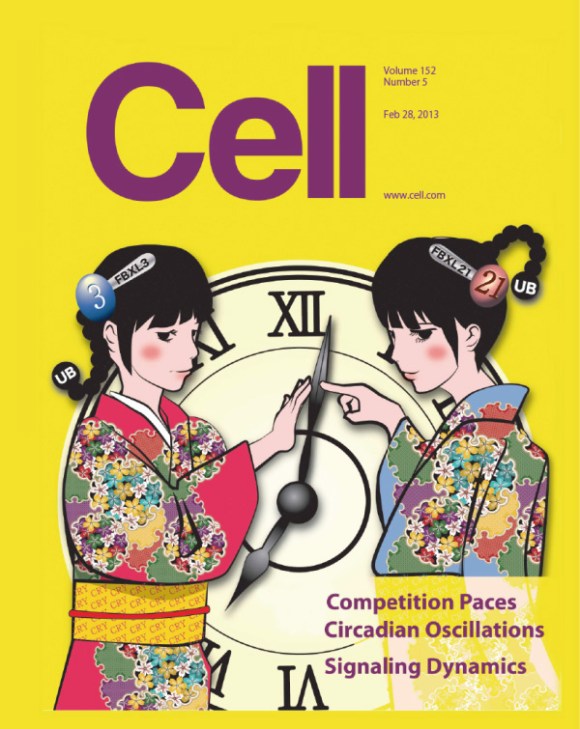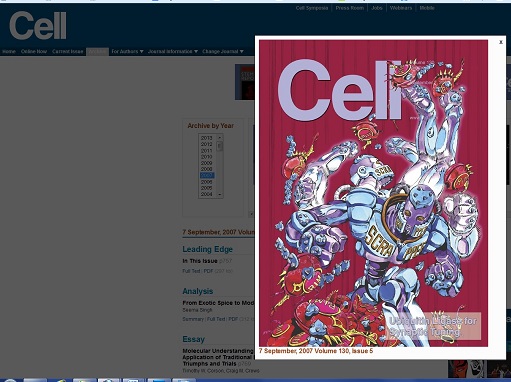
Take a good look at this cover for the 28 Feb. issue of noted science journal Cell. If you can tell me what this image means without reading the article then I’ll give you a shiny nickel!*
We see two young women wearing kimonos each with a hand on the minute hand of a giant clock. There are various letters and numbers printed on them, but what does it all mean?
The cover design is based on an article submitted by a research team from Tokyo University titled: FBXL21 Regulates Oscillation of the Circadian Clock through Ubiquitination and Stabilization of Cryptochromes.
Don’t worry, there’s simple summary to explain what that means.
“In the mammalian circadian clockwork, CRY1 and CRY2 repressor proteins are regulated by posttranslational modifications for temporally coordinated transcription of clock genes. Previous studies revealed that FBXL3, an F-box-type E3 ligase, ubiquitinates CRYs and mediates their degradation. Here, we found that FBXL21 also ubiquitinates CRYs but counteracts FBXL3. Surprisingly, FBXL21 stabilized CRYs and antagonized the destabilizing action by FBXL3.”
In English, that means our bodies have a type of built-in clock that runs on a 24-hour cycle conveniently matching one rotation of the Earth. This helps our bodies perform the best inner processes for what it expects us to be routinely doing (sleeping, working, etc).
This clock (often called a “circadian clock”) is managed by proteins called CRY. Two enzymes called FBXL21 and FBXL3 interact with the CRY proteins. These two enzymes are different in their structure and location of a protein called ubiquitin (Ub).
FBXL3 breaks down the CRY which moves our body’s sense of time forward. On the other hand, the FBXL21 preserves CRY and slows down its degradation caused by FBXL3. While FBXL3 drives the clock forward FBXL21 provides a little resistance. As a result this stabilizes our inner clock to a constant 24 hours.
Okay. Now you can look at the picture again.
The research is hoped to lead to treatments of disorders and diseases caused by abnormal body clocks.
Cell has used various talented people to design their covers over the years. This one was done by Yuki Takahashi. Another cover designed by a Japanese person was from the 7 Sept. 2007 issue done by the creator of JoJo’s Bizarre Adventure, Hirohiko Araki.
I would explain what this one means, but I’m suddenly very sleepy. For some reason reading scientific journals makes me really drowsy. Something must be wrong with my CRY proteins.
Source: Cell (English) via IT Media (Japanese)
Top Image: University of Tokyo
*Note: Payment of the shiny nickel will only be made when the winner finds me on the street and pulls a gun on me… Then I suppose you can have all the nickels you want.


 Japanese manga artist shares his creative process for making a manga volume’s front cover
Japanese manga artist shares his creative process for making a manga volume’s front cover Kyoto University finds alpacas may hold the key to preventing all COVID-19 variants
Kyoto University finds alpacas may hold the key to preventing all COVID-19 variants They have teeth in their stomaches! And 6 other fun facts about cockroaches
They have teeth in their stomaches! And 6 other fun facts about cockroaches Get those gains and a protein boost with Muji’s newest, limited edition cricket crackers
Get those gains and a protein boost with Muji’s newest, limited edition cricket crackers McDonald’s new Happy Meals offer up cute and practical Sanrio lifestyle goods
McDonald’s new Happy Meals offer up cute and practical Sanrio lifestyle goods Tokyo Tsukiji fish market site to be redeveloped with 50,000-seat stadium, hotel, shopping center
Tokyo Tsukiji fish market site to be redeveloped with 50,000-seat stadium, hotel, shopping center Japanese ramen restaurants under pressure from new yen banknotes
Japanese ramen restaurants under pressure from new yen banknotes We tried Korea’s way-too-big King Tonkatsu Burger at Lotteria 【Taste Test】
We tried Korea’s way-too-big King Tonkatsu Burger at Lotteria 【Taste Test】 Sakura tree falls on man at Sannenzaka near Kiyomizu temple in Kyoto 【Breaking News】
Sakura tree falls on man at Sannenzaka near Kiyomizu temple in Kyoto 【Breaking News】 Mt. Koya planning to instate visitor’s tax to cope with huge tourist numbers
Mt. Koya planning to instate visitor’s tax to cope with huge tourist numbers French Fries Bread in Tokyo’s Shibuya becomes a hit on social media
French Fries Bread in Tokyo’s Shibuya becomes a hit on social media Cosplay in front of explosions and flames at the upcoming fiery Baku Festival
Cosplay in front of explosions and flames at the upcoming fiery Baku Festival Wendy’s releases a Pretzel Roast Beef Burger aimed at foreign tourists in Japan
Wendy’s releases a Pretzel Roast Beef Burger aimed at foreign tourists in Japan New private rooms on Tokaido Shinkansen change the way we travel from Tokyo to Kyoto
New private rooms on Tokaido Shinkansen change the way we travel from Tokyo to Kyoto All-you-can-drink Starbucks and amazing views part of Tokyo’s new 170 meter-high sky lounge
All-you-can-drink Starbucks and amazing views part of Tokyo’s new 170 meter-high sky lounge More foreign tourists than ever before in history visited Japan last month
More foreign tourists than ever before in history visited Japan last month Starbucks reopens at Shibuya Scramble Crossing with new look and design concept
Starbucks reopens at Shibuya Scramble Crossing with new look and design concept Studio Ghibli releases new action figures featuring Nausicaä of the Valley of the Wind characters
Studio Ghibli releases new action figures featuring Nausicaä of the Valley of the Wind characters Studio Ghibli glasses cases let anime characters keep an eye on your spectacles
Studio Ghibli glasses cases let anime characters keep an eye on your spectacles Is the new Shinkansen Train Desk ticket worth it?
Is the new Shinkansen Train Desk ticket worth it? Beautiful Ghibli sealing wax kits let you create accessories and elegant letter decorations【Pics】
Beautiful Ghibli sealing wax kits let you create accessories and elegant letter decorations【Pics】 Studio Ghibli releases Kiki’s Delivery Service chocolate cake pouches in Japan
Studio Ghibli releases Kiki’s Delivery Service chocolate cake pouches in Japan New definition of “Japanese whiskey” goes into effect to prevent fakes from fooling overseas buyers
New definition of “Japanese whiskey” goes into effect to prevent fakes from fooling overseas buyers Our Japanese reporter visits Costco in the U.S., finds super American and very Japanese things
Our Japanese reporter visits Costco in the U.S., finds super American and very Japanese things Studio Ghibli unveils Mother’s Day gift set that captures the love in My Neighbour Totoro
Studio Ghibli unveils Mother’s Day gift set that captures the love in My Neighbour Totoro Domino’s Japan now sells…pizza ears?
Domino’s Japan now sells…pizza ears? New Japanese KitKat flavour stars Sanrio characters, including Hello Kitty
New Japanese KitKat flavour stars Sanrio characters, including Hello Kitty New Pokémon cakes let you eat your way through Pikachu and all the Eevee evolutions
New Pokémon cakes let you eat your way through Pikachu and all the Eevee evolutions Sales of Japan’s most convenient train ticket/shopping payment cards suspended indefinitely
Sales of Japan’s most convenient train ticket/shopping payment cards suspended indefinitely Sold-out Studio Ghibli desktop humidifiers are back so Totoro can help you through the dry season
Sold-out Studio Ghibli desktop humidifiers are back so Totoro can help you through the dry season Japanese government to make first change to romanization spelling rules since the 1950s
Japanese government to make first change to romanization spelling rules since the 1950s Ghibli founders Toshio Suzuki and Hayao Miyazaki contribute to Japanese whisky Totoro label design
Ghibli founders Toshio Suzuki and Hayao Miyazaki contribute to Japanese whisky Totoro label design Doraemon found buried at sea as scene from 1993 anime becomes real life【Photos】
Doraemon found buried at sea as scene from 1993 anime becomes real life【Photos】 Tokyo’s most famous Starbucks is closed
Tokyo’s most famous Starbucks is closed One Piece characters’ nationalities revealed, but fans have mixed opinions
One Piece characters’ nationalities revealed, but fans have mixed opinions We asked a Uniqlo employee what four things we should buy and their suggestions didn’t disappoint
We asked a Uniqlo employee what four things we should buy and their suggestions didn’t disappoint Princesses, fruits, and blacksmiths: Study reveals the 30 most unusual family names in Japan
Princesses, fruits, and blacksmiths: Study reveals the 30 most unusual family names in Japan We buy the lowest-rated alarm clock on Amazon Japan
We buy the lowest-rated alarm clock on Amazon Japan Clever alarm system invented by Japanese railway company will wake even the deepest of sleepers
Clever alarm system invented by Japanese railway company will wake even the deepest of sleepers New Studio Ghibli clocks let you keep an eye on the time with your favourite anime characters
New Studio Ghibli clocks let you keep an eye on the time with your favourite anime characters What time appears most in Japanese and English song lyrics?
What time appears most in Japanese and English song lyrics? The dirty reason China can’t always tell North Korea what to do
The dirty reason China can’t always tell North Korea what to do Japanese cat and dog clocks with swishing tails make clock-watching more adorable than ever
Japanese cat and dog clocks with swishing tails make clock-watching more adorable than ever Study shows broccoli sprouts may regrow hair, and not just on Chia Heads
Study shows broccoli sprouts may regrow hair, and not just on Chia Heads Japanese university student makes stunning wooden clock that literally writes the time 【Video】
Japanese university student makes stunning wooden clock that literally writes the time 【Video】 Kansai area people more genetically predisposed to liking coffee than elsewhere in Japan
Kansai area people more genetically predisposed to liking coffee than elsewhere in Japan Famed educator says Steve Jobs, Bill Gates would have been ruined by Japanese education system
Famed educator says Steve Jobs, Bill Gates would have been ruined by Japanese education system We arrive at Pokémon GO Fest 2019 Chicago to up our game, scout out shinies
We arrive at Pokémon GO Fest 2019 Chicago to up our game, scout out shinies Studio Ghibli releases a Catbus clock in Japan with loads of cute details
Studio Ghibli releases a Catbus clock in Japan with loads of cute details Neo Kimono releases innovatively traditional heel covers made from artisanal fabric
Neo Kimono releases innovatively traditional heel covers made from artisanal fabric Great news: New study shows beer may help curb Alzheimer’s
Great news: New study shows beer may help curb Alzheimer’s Japanese researchers create chickens that lay eggs containing valuable medicine
Japanese researchers create chickens that lay eggs containing valuable medicine
Leave a Reply